The Step-by-Step Amazon FBA Guide for 2026
- Modified: 26 December 2024
- 13 min read
- Ecommerce, Grow Your Business
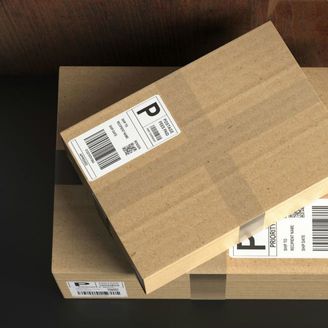

Heather Cameron
Author
Heather believes in the power of great storytelling and is here to craft compelling copy that informs and inspires readers. With an extensive background in digital marketing, she has experience writing for various industries, from finance to travel. As Osome’s copywriter, Heather creates content that empowers entrepreneurs and small business owners to boost their business with expert guidance, helpful accounting tips and insights into the latest fintech trends.
Ready to start or grow as an Amazon FBA seller? Use this guide to navigate Fulfilment by Amazon (FBA) with ease. Avoid common mistakes and understand the basics behind selling on Amazon, from setting up an account to sending products to your buyers.
Key Takeaways
- Fulfilment by Amazon, or FBA, is a game changer for ecommerce business. It takes charge of storage, manages inventory, handles shipping, and provides customer service for Amazon sellers, easily increasing sales and brand trust.
- Amazon FBA begins with professional sellers sending products to Amazon, which are stored at Amazon fulfilment centres. Once a customer orders, the fulfilment centre ships the product to fulfil an order.
- Products in your Amazon store also become eligible for Prime benefits, and Amazon’s customer service handles after-sales interactions.
- To sell on Amazon using FBA, you will need to pay the associated costs including pre-fulfilment fees, monthly storage fee, shipping costs, and other related expenses.
- To succeed with Amazon FBA, you need a smart setup (including a well-crafted product listing with good SEO) and a strategic approach to costs, inventory, and marketing using tools like PPC and the Brand Registry.
What Is Amazon FBA and How Can It Help Your Business?
Fulfilment by Amazon (FBA) is a service offered to third-party sellers. It lets you outsource your products' storage, packing, shipping and customer service to Amazon’s massive fulfilment network. With the FBA, Amazon will:
- Store your products
- Pick and pack your products
- Ship your products
- Provide customer service in various local languages
Partnering with ecommerce accountants from Osome can free you to focus on expanding your product offerings and reaching new customers while they handle the intricate details of your finances. Contact us today to learn more and get started!
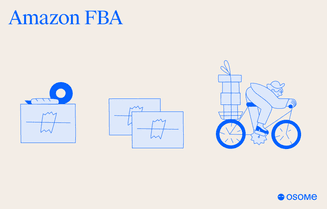
Imagine having an ecommerce giant in your corner, helping your brand and sales grow by 35% while providing you access to global selling and a robust support team. That's pretty much guaranteed business growth.
Here are the main benefits of running an Amazon business via FBA:
- You can reach potential customers around the world.
- You receive professional-level support for your online store.
- With Amazon handling the logistics, you can sell globally, so customer service is fast and smooth.
- As an FBA seller, your products get the spotlight, which comes with customers' trust in Amazon, giving you a big advantage in the ecommerce game.
5 Steps on How To Use Amazon FBA
Sell on Amazon is a 5 step process that starts with sending your products to Amazon and ends with you sitting back as Amazon handles customer interactions. Once you've set up your Amazon selling account, you're ready to initiate this process.
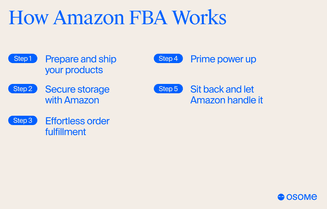
Step 1: Send your products
To sell products on Amazon, you must send them to Amazon’s fulfilment centres first by:
- Visit Seller Central. Select your inventory and create a shipment plan through the ‘Send to Amazon’ workflow on the homepage.
- Whether you’re sending identical items in case packs or a mixed bag of individual units, Amazon Seller Central has templates and guides for prepping and labelling.
- Weigh and measure your boxes and note any special handling requirements.
- Print your shipping labels. No barcodes are required for shipping.
Step 2: Amazon stores your items
Once your products arrive at the Amazon fulfilment centres, they’re in safe hands. Amazon’s warehouses are treasure troves where your items wait in the wings. The beauty of Amazon’s system is its consolidated inventory approach, where your stock is aggregated and ready to be fulfiled by Amazon itself or other channels through multi-channel fulfilment.
This makes life easier for you and means you’re not missing out on any sales.
Step 3: Customers buy, Amazon fulfils
Imagine this: a customer clicks ‘Buy Now’ on your product in the Amazon store, and without you lifting a finger, Amazon does it all. The order is picked, packed and shipped, and your customer’s excitement is met with fast delivery. But what about the financials behind the magic?
Multi-channel fulfilment can simplify order fulfilment but don’t forget the importance of ecommerce accounting. Tracking inventory, managing sales across multiple channels, and complying with taxes can get complicated as your business grows.
Step 4: Prime perks
Step four is where the magic of Amazon Prime kicks in. Your FBA-enrolled products become eligible for all Prime benefits, including free 2-day shipping. This badge of honour makes your product more attractive and visible and gives you access to Prime members known for being loyal and big spenders.
Step 5: Sit back, Amazon’s got it
Finally, sit back and enjoy the peace of mind that comes with FBA. As an Amazon FBA seller, you can trust Amazon’s customer service team to handle inquiries, returns, and most refunds so that your buyers are looked after.
Once your products are in the network, Amazon handles:
- Order processing
- Picking and packing
- Shipping and delivery
- Customer service
So you can focus on growing your business without getting bogged down in the details.
How To Set Up Your Amazon Seller Account?
Choose the right plan for. Choose "Individual" if you’re just testing the waters or "Professional" if you’re all in and ready to scale. New sellers will also need a bank account, credit card, government ID, tax info and a phone number to set up the selling account.
For those eager to conquer the North American marketplaces, make sure your credit card and tax information are prepped for the journey.
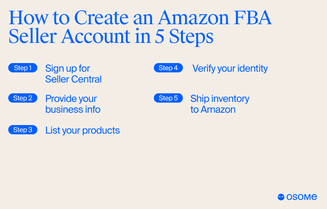
What Are the Amazon FBA Costs?
Selling on Amazon using FBA services isn’t just about the profits but also the costs. The FBA program is designed to be scalable and cost-effective, but you need to know the numbers to price your products correctly and keep your profits healthy.

There are three main types of FBA cost: Amazon FBA fees, monthly storage fee, shipping fees and additional selling fees. These costs are calculated per unit and per order and vary based on size, weight, and storage duration. Standard-sized items have relatively low costs, larger items will have higher costs, and there may be surcharges if you go over Amazon’s usage limits.
Amazon Selling Fees
Selling on Amazon has its own set of fees, mainly the referral fee for each item sold. This fee equals to 8-15% of the selling price, depending on the product category. For most items, it is 15%, so you’ll want to factor this into your pricing from the start.
FBA Costs
FBA fees are like a puzzle: You need to pay attention to the details and understand how each piece fits into the bigger picture. Per-product fulfilment fees cover the cost of packaging and shipping and vary depending on the product and the market in which it’s sold.
Your monthly storage fee is based on your Amazon inventory volume. Don’t forget the long-term storage fees for items that sit longer and additional costs for extra services like advertising.
Shipping fees are calculated by category, weight and season (before or after April 15). For example, the current cost of shipping products weighing 2oz or less is $3.06. But the cost to ship small apparel package 4oz or less is $3.27.
But managing these complexities doesn't have to be a solitary endeavour. Empower your FBA journey with expert ecommerce accounting. Expert ecommerce accountants simplify FBA finances. Focus on growing your business; Osome'll handle the numbers. Contact us to optimise costs and maximise profits.
How To Craft a Successful Product Listing?
Creating a standout product listing is an art form that can make you stand out in the Amazon jungle. Your product title should be a search engine magnet, with highly searched keywords and product details to grab the attention of potential buyers. Images are your silent salespeople, so invest in high-resolution photos and infographics that can make the sale.
Don’t forget the bullet points and product descriptions. They are your canvas to paint the benefits of your product with more keywords and brand storytelling. And when it comes to pricing, be smart—a smart approach can mean the difference between blending in and standing out.
SEO and Keywords
In the digital marketplace, SEO advancement operates as your product’s loudspeaker. It helps to amplify your listing’s visibility, connect you with customers who are searching for what you have. Keyword research isn’t just guessing; it’s a science with tools like Jungle Scout’s Keyword Scout to help you see what customers are searching.
Using a mix of short-tail and long-tail keywords in your product titles and descriptions will help you balance broad appeal and niche targeting.
Winning the Buy Box
The Buy Box is the source of most sales. To be included in a box, you must optimise your offers and monitor the product's pricing, availability, and customer satisfaction metrics. FBA sellers have a leg up in this race, as Amazon favours listings that promise reliable and speedy fulfilment. Even if you're not using FBA, powerful Amazon Seller Tools are also available to help you with everything from product research and keyword optimisation to competitor analysis and listing creation.
Inventory Management and FBA Restock Tool
Managing your FBA inventory is a juggling act that greatly impacts your Amazon FBA success. The FBA inventory system is your control centre, tracking shipments and stock levels, while the inventory dashboard is a window into your restock needs and lost sales.
It can be tricky to keep track of remaining stock to avoid out-of-stock situations. Thankfully, Amazon's Seller Central provides useful gadgets like the FBA Restock Inventory tool that give you custom recommendations for restocking, taking into account your sales history and projected demand so you don’t overstock or stock out.
Shipping and FBA Shipment Processes
Your product's journey begins when you send it to Amazon’s warehouse. Proper prep, labelling, and packing are the key steps to getting your products ready for their big debut. A well-thought-out shipping plan and correctly applied Amazon shipment ID labels are your ticket to a smooth journey to the warehouse. Labelling is especially important, as each box and individual unit needs to be labelled with the correct categories and ownership details.
Select your shipping method—small parcels for the small guys or less-than-truckload for the big boys—and use an Amazon-approved carrier for discounted rates and tracking.
How Do You Amplify Sales with Amazon PPC and Brand Registry?
To really stand out on Amazon, you need a solid PPC strategy to highlight your products. Amazon PPC ads can guide customers to your listings through keyword targeting and showing up in search results and on competitor pages. As a result, they can significantly improve your sales volume. But it’s not just about paying for visibility; you need to track:
- Advertising Cost of Sales (ACoS)
- Attributed sales
- Impressions
- Clicks
And don’t just stick to Amazon’s ecosystem—consider other marketing channels, like social media or external paid ads, to expand your reach.

Amazon PPC for Visibility
Amazon Sponsored Products is a targeted pay-per-click solution to give your Amazon FBA store the visibility boost it needs. Use Amazon’s Product Opportunity Explorer and Brand Analytics to get insights into customer search behaviour and refine your keyword strategy. Whether you let Amazon’s algorithms drive your automatic targeting or you manually choose keywords for your ads, the goal is clear: increase impressions and sales.
For brand-registered sellers, the advertising options open up even more with Sponsored Display ads that reach beyond Amazon to other platforms, increasing your brand’s reach. Don’t be afraid to allocate a decent budget and competitive bids to get your campaigns going.
How to leverage Amazon Brand Registry?
The Brand Registry is the safe house for Amazon brand owners. This program gives you more protection and control over your product detail pages so your brand can stand out in a busy market. The registry also gives you access to tools and benefits to boost your brand presence and customer trust, the foundations for long-term success.
FBA Business Models: Private Label and Beyond
The FBA landscape is dotted with a variety of ecommerce business models, each with its own set of strategies and potential rewards. The private labeling approach is favoured by a significant number of Amazon sellers, as it allows them to:
- Market products manufactured by others under their own brand
- Enjoy high profitability
- Scale their business, especially in popular categories like Home & Kitchen or Beauty & Personal Care.
To help manage inventory, sellers using private labels can purchase upc code unique to each product through Amazon. This allows you to label different variants of the same product individually and hence make tracking more efficient.
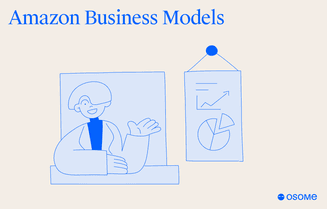
Then there’s wholesale, where sellers buy products in bulk at discounted rates and resell them individually on Amazon – a straightforward model that relies on finding the right deals. Retail arbitrage, on the other hand, is a treasure hunt for discounts and clearances across other ecommerce platforms or brick-and-mortar stores. It’s a model that allows for a lower upfront investment, with many sellers getting started with less than $1,000.
While each model has its unique nuances, they all share a common goal – leveraging Amazon’s colossal marketplace to turn a profit and grow an ecommerce empire.
Ecommerce accountants understand the intricacies of the Amazon marketplace and can help you navigate complex tax regulations, optimise your pricing strategies for maximum profitability, and ensure your finances are in order for future growth.<br>
How To Grow Your Amazon FBA?
Expanding your reach with the Amazon FBA program has never been easier with Amazon’s international selling capabilities that reach hundreds of millions consumers in every corner of the world.
With the North America Unified Account, sellers can manage their business across the US, Canada and Mexico without multiple subscriptions. But remember, each marketplace requires active management through your seller central account to make sure your listings are optimised and targeted to each region’s audience.
Embrace this opportunity to start selling and scale your business, introducing your products to a whole new world of customers.
When and How To Expand Your FBA Business?
Consistently beating your sales targets is the telltale sign that it’s time to grow. If you’re turning away profitable opportunities because of resource constraints, it’s time to evaluate how you've been selling online and start to scale your operations.
But before you make that leap, make sure your foundation is solid with systems and processes in place. Look back at your business’s past performance, learn from it and improve the areas that need it. As you scale, don’t forget to strengthen your quality control processes – key to customer trust and a great experience.
Summary
The beauty of Amazon FBA is that it simplifies the complex logistics of ecommerce, allowing Amazon sellers to focus on growing their brand and reaching a global audience. Remember, success in FBA is not just about selling; it’s about building a robust and scalable business with the right strategies and tools. Embrace the power of Amazon FBA, and watch your business soar to new heights. For seamless FBA finances, get expert ecommerce accounting with Osome.






